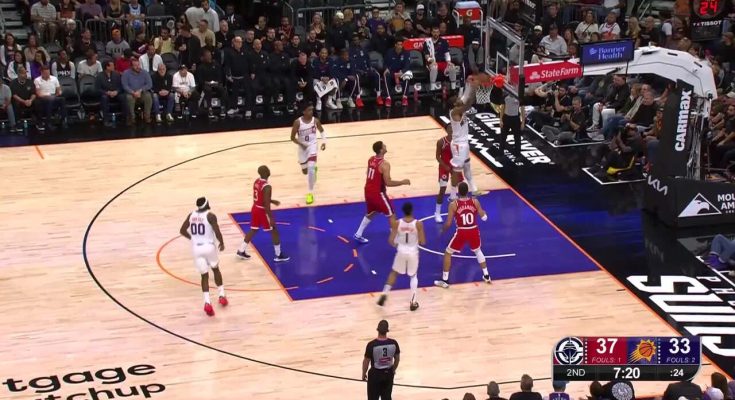The moment felt like it belonged on a poster, but not the kind offensive players dream about. Instead, it was the type of play defenders hope will be replayed endlessly, slowed down frame by frame, and remembered as a turning point—or at the very least, a statement. Nick Richards, known mostly for his size, effort, and underrated touch around the basket, provided a moment that reminded everyone watching that he is much more than a complementary piece. He is, when locked in, a legitimate defensive force capable of altering the emotional temperature of a game in a single second. And in this matchup between Indiana and Phoenix, broadcast to fans on NBA League Pass, he did exactly that.
The possession didn’t begin as anything special. Phoenix pushed the ball up the floor after a routine rebound, looking to establish rhythm before Indiana’s defense could get fully set. The Suns were focused on speed and downhill pressure, an approach that has served them well throughout the season as they search for early offense before teams can load up on their star talent. The guard handling the ball surveyed his options, saw a seam in transition, and drove with confidence, knowing that even if he didn’t finish at the rim, he could collapse the defense and force help rotations that would open something easy on the perimeter. It was a strong read and a controlled attack, the type of play teams emphasize repeatedly during film sessions.
Indiana’s perimeter defenders did their best to stay connected, but you could sense the shift in momentum as Phoenix carved into the lane. For a brief moment, it looked like a high-percentage bucket was inevitable. The crowd’s energy rose in anticipation, and even the broadcasters were beginning to elevate their voices, that familiar cadence creeping in as a play neared its climax. But while the ball-handler was making his move, Richards was already diagnosing the action two steps ahead. It wasn’t the first time he’d been put in that exact position, and he responded with the instincts of a player who has learned how to maximize his athletic gifts.
What separates a routine block from a highlight-of-the-night swat often comes down to timing. And Richards timed this one to perfection. As the Phoenix player gathered to rise, confident in the daylight he’d created, Richards took one powerful stride toward the restricted area. He elevated with a fluid explosiveness that belied his size. His eyes were fixed not on the player but on the ball, tracking its upward flight like a trained defender reading a quarterback’s throw. In that split second, all the variables aligned: his angle, the ball’s trajectory, the momentum of the offensive player, and the point at which their paths would intersect. And then, with force and clarity, everything collided.
The block wasn’t a subtle tap, nor was it merely a contest that altered the shot. It was a definitive rejection, a shutdown of the play at its very apex. Richards’ hand met the ball with such authority that even the attacker seemed frozen mid-air, unable to fully process what had happened until he was already back on the ground. The ball ricocheted off Richards’ palm and sailed upward before dropping into the hands of a teammate, who pushed the ball quickly the other way. Instantly, Indiana turned the massive defensive moment into an opportunity to run, flipping the emotional script in real time.
Crowds always respond differently to blocks depending on timing, context, and impact, but this one had the special quality that creates immediate buzz. Fans jumped from their seats. Benches reacted in unison with that wide-eyed, hands-on-head disbelief reserved for only the most spectacular defensive plays. The camera angle captured Richards’ expression afterward—calm, no extra celebration, just the satisfied seriousness of a player who knows he did something special yet understands that possessions keep coming and that defense requires a short memory. But you could tell he felt the electricity. Everyone in the building did.
Richards is not always placed in the spotlight, even in games where he plays well. Much of his work is subtle: verticality, rim deterrence that doesn’t show up in highlights, setting screens that free guards, rolling hard to force help, occupying defenders on the weak side, contesting shots that the stat sheet won’t give him credit for. But these are the types of moments that remind viewers how valuable he can be. Rim protection is one of the NBA’s most coveted defensive skills, and when a player vividly demonstrates how much space he can shut down, he shifts the way opponents attack for the rest of the night. After that block, Phoenix became noticeably more cautious on drives, aware of where Richards was at all times.
In some ways, the play also encapsulated the broader growth Richards has shown. Early in his career, he was raw, trying to find consistency, occasionally tentative when making defensive reads. But over time, with patience, coaching, and repetitions, he’s sharpened his instincts. He’s quicker to react, more disciplined in avoiding fouls, and more confident seeking contact at the rim. That maturity was on full display during this particular denial—he didn’t bite on pump fakes, didn’t overcommit, and didn’t arrive too early or too late. Instead, he landed at the exact moment when his impact would be most forceful.
The Suns responded by shifting their offense slightly, moving the ball more deliberately and relying on perimeter creation. But even as they adjusted, the memory of the block lingered. It’s the type of play that forces coaches to rethink which actions they’re comfortable attacking the rim from. It can make even elite scorers second-guess drives that would normally feel like automatic two points. Defenders like Richards don’t just affect individual possessions—they shape decision-making.
On Indiana’s side, the play served another purpose: momentum. Basketball is often described as a game of runs, but it’s also a game of emotional anchors—moments that define the attitude and energy of a team. After the block, Indiana’s intensity visibly increased. Guards picked up their men higher on the perimeter. Wings fought harder through screens. The ball movement on offense sharpened. Everyone fed off the defensive anchor that Richards had provided. It was as though the entire roster collectively decided that if Richards was going to set that tone at the rim, they would match it everywhere else on the floor.
The importance of plays like this extends beyond a single game, too. Coaches use them in film study to reinforce principles: verticality, timing, help responsibilities, communication. Young players study them to understand how to read an attack and where to be positioned. Big men facing similar situations throughout the league will look at a sequence like this and model their footwork or timing after Richards’ mechanics. It becomes a teaching moment as much as a highlight.
And for fans, it’s pure entertainment. There is something uniquely thrilling about a block that stops a sure basket. Dunks are celebrated because they represent dominance, power, flair—but blocks represent resistance, defiance, and the refusal to yield. They are defensive dunks, dramatic inversions of the same spectacle. When done at the rim, at full elevation, against an aggressive attacker, they evoke that same visceral excitement. The combination of athleticism, anticipation, and sheer physicality is unmistakable.
This block was not just a play—it was a message. Richards communicated through action that he intended to own the paint, that drives would come with consequences, and that this game, at least for that moment, belonged to him defensively. It takes a certain mentality to step into that role. Many players are big and athletic; fewer have the timing and confidence to challenge plays at the highest point. Richards showed he is one of those few.
If the game ends up being remembered for its intensity, its pace, or the stars on either side, this play will still stand out. The replay packages will feature it prominently. Social media clips will capture fans’ reactions, slow-motion breakdowns, and commentary from analysts discussing its significance. It will be shared, reshared, paused, zoomed, and dissected. And at the center of all of that attention will be Nick Richards elevating with purpose, refusing to concede, and producing a denial that instantly earned the label “HUGE.”
That’s what makes moments like this so memorable. They exist at the crossroads of athleticism and instinct, spectacle and substance. They remind fans why defense is every bit as thrilling as offense when performed at the highest level. They show how individual effort can ripple through an entire team. They create lasting images—an outstretched arm, a stunned offensive player, a shifted momentum, a roaring crowd.
Nick Richards delivered all of that in one breathtaking sequence, a single second that told a complete story. And for those watching on NBA League Pass, it was exactly the kind of moment that makes the subscription worth it: something unexpected, explosive, and unforgettable, the kind of play that makes you lean forward, shout out loud, or simply laugh in amazement because you can’t believe what you just saw. It was a rim defense masterpiece, a highlight that will live far beyond the final buzzer, a reminder that on any given night, a single play can redefine a game’s energy and showcase a player’s rising impact.



